|
Bhagat Singh Research Scholar Central University of Haryana |
Dr. Sunita Tanwar Assistant Professor Central University of Haryana |
The article has studied the process of Competitive Intelligence in Indian retail firms. The 168 firms operating in retail sector have been selected for study from National Capital Region of India. The Calof and Dishman's model of competitive intelligence is used to study the process. Calof and Dishman's model of competitive intelligence based on the consideration that Competitive Intelligence is a process which consists of planning and focus, collection, analysis, and communication of intelligence, as well as the necessary processes and structures and an organizational awareness and culture Based on the score of Indian Retail firms on the process of Competitive Intelligence, It was concluded that Indian firm are strong in Communication and Analysis, Internal Information and Formal Infrastructure but weak in Planning and Focus and Employee Involvement
Keywords: Competitive Intelligence, Indian Retail Industry, Calof and Dishman's model.Today's business environment is changing very fast. Due to the social network consumers can exchange information faster than ever before. New development of technology is helping by creating new industries. Online stores are creating global competition. The business environment is extremely dynamic. The challenge is to be continuously on the lookout for new opportunities and transforming the organizations objectives, skills, resources and capabilities as per the need of time to grasp the opportunities. Companies are using different processes and techniques to study the environment in which they are operating. Earlier companies were using Industrial Espionage to collect the information. The famous case of Tea industry in Europe, which was the monopoly of china in 1800s and Europe was having a huge demand of tea. The London based East India company hired Scottish botanist and adventurer Robert Fortune to transfer the seeds, plants and trade secrets from China to British ruled India within a period of 25 years Indian tea production surpass the production of China. Some 2400 years ago the work of Sun Tzu titled “The Art of War” is considered to be the origin of CI. In 1815 Nathan Rothschild makes his fortune in London stock exchange because of having timely information about the outcome of battle of waterloo. Although Competitive Intelligence have been practiced since ancient time but it is relatively a new area in academic research. Competitive Intelligence has been studied in different countries of the world. It has been studied in countries like China, USA, UK, Japan, South Africa etc. but it has not been studied in India yet. No focus has paid till date on the environment scanning practices of Indian Industries. At present due to liberal FDI policy of India, Indian retail sector is passing through a very tough competition. The objective of this study is to access the status of competitive intelligence practice in Indian retail Industry.
Competitive Intelligence is not a new concept. Many competitive intelligence articles refer to the work of Sun Tzu, who has some 2400 years ago written “The art of war” a seminal text which provides a detail description of how to develop a military intelligence. (Rouach & Santi, 2001). In ancient time it was a practice of Spying and espionage. In 1815 Nathan Rothschild makes a fortune on London stock exchange due to his timely intelligence about battle of waterloo(Ferguson, 1998).In the modern era the Kelly's Book Marketing Intelligence...(1965) considered to be the pioneering work in competitive intelligence. It introduced the field of Intelligence. Nearly 30 years ago, Porter reported that whilst companies were carrying out this activity informally, in his opinion this was nowhere near sufficient. He advocated the need for a structured intelligence process at all times in order to continuously and systematically identifying business opportunities and threats (Porter, 1980). Although competitive intelligence evolved out of marketing the activities of the discipline have come to serve all business functions. ``Research and development'' people seek to monitor rival organizations while safeguarding their own data. Possessing information such as the production capabilities of a competitor's factories, furthermore, can provide valuable insights. The financial health of a competitor may influence a decision to confront the rival ``head on'' or to strategically avoid direct conflict. Although competitive intelligence began as a special area of marketing research, it has grown beyond its origins and today it provides information in all areas (Walle,1999, Dishman & Calof, 2008). In business and academics there are many synonym terms for competitive intelligence used by different researchers for example Environmental Scanning(Aguilar, 1967)(Saxby, Parker, Nitse, & Dishman, 2002), Business Intelligence(Pearce, 1976), Competitor analysis(Ghoshal & Westney, 1991), Marketing Intelligence(Kelley, 1965).Market Intelligence(Maltz & Kohli, 1996). Intelligence helps your company sustain and develop distinct competitive advantages by using the entire organization and its networks to develop actionable insights about the environment (customers, competitor, regulars, and technology). It uses a systematic and ethical process involving, planning, collection, analysis, communication and management (Calof, 2008). According to Kahaner Competitive Intelligence is a systematic programme for gathering and analyzing information about your competitor's activity and general business trends to further your own companies' goals(Kahaner, 1998).The Society of Competitive Intelligence Professionals (SCIP) define the competitive intelligence as follows "Competitive intelligence (CI) is the process of monitoring the competitive environment. CI enables senior managers in companies of all sizes to make informed decisions about everything from marketing, R&D, and investing tactics to long-term business strategies. Effective CI is a continuous process involving the legal and ethical collection of information, analysis that doesn't avoid unwelcome conclusions, and controlled dissemination of actionable intelligence to decision makers”
The past research measured competitive intelligence capabilities of the firm with different ways. The literature provided two prominent models on measuring competitive intelligence. The one is based on the best practice model called Wright-Pickston best practice model (Wright, Pickton, & Callow, Competitive intelligence in UK firms: a typology, 2002). In this model the firm's capabilities of competitive intelligence measured on four parameters Attitude, Gathering style, Use and Location of competitive intelligence department in the firm. On the basis of Attitude firms are further categories as Immune, Task driven, Operational and Strategic. Gathering style further categorized as Easy and Hunter. Whether uses type is Joneses, Knee jerk, Tactical user or Strategic user and location of Competitive Intelligence department is Adhoc or Designated. On the basis of these four parameters the best practice model consists of Strategic Attitude, Hunter gathering, Strategic User and Designated location. This model is Called Wright-Pickston Model. (Wright, Pickton, & Callow, 2002). (Wright, Eid, & Fleisher, Competitive intelligence in practice: empirical evidence from the UK retail banking sector, 2009). The second model is called Calof and Dishman's model of competitive intelligence based on the consideration that Competitive Intelligence is a process which consists of planning and focus, collection, analysis, and communication of intelligence, as well as the necessary processes and structures and an organizational awareness and culture. Based on the above propositions and preliminary research, How much extant firms follow this process is need to measure. The above theoretical consideration first used by (Sawka, Frances, & Herrin, 1995) in developing the measurement tool. Calof and Dishman (2002) further refined it and proposed the following model (Figure 1).The same model is further refined and used by (Viviers, Saayman, Muller, & Calof, 2002) in South Africa. This model further improved and published by (Dishman & Calof, 2008) and (Saayman, et al., 2008)

In the research tools the final statements is taken from (Saayman, et al., 2008). The final questionnaire contains 38 CI-related statements to be answered on a five-point Likert scale. The Likert scale questions were divided into two sections. In the first section the respondent has to indicate to which degree he/she agreed or disagreed with 17 statements. In the second part 21 statements the respondents had to indicate to what extent (never to always) they implemented a certain action. The 38 statements further divided in to two parts one is Process of Competitive Intelligence and Second part is the context of Competitive Intelligence. The competitive intelligence process is having three factors Communication and Analysis, Collection and Planning and Focus. The context of competitive intelligence has four factors Awareness, Internal Information, Formal Infrastructure and Employee Involvement.
The survey was conducted in the Delhi NCR region of India where the retail outlets were selected on the basis of convenience sampling. The data were collected from Connaught Place, South Extension Markets in Delhi and Ambience Mall, MG Road from Gurugram. Apart from these markets the research has collected the data from Retail Trade shows. The questionnaire was field by the Owner, CEO/Director, Marketing Head, Cluster Head or Store Manager. The response of 175 firms have been recorded out of that 7 firms have missing values of more than 50 percent so the responses of these 7 firms has been not feed in to the analysis.
Analysis of missing value by Little's MCAR test was performed to identify non response biasness. The chi square value is 2061.433, DF=2246, Sig = .998. The null hypothesis for Little's MCAR test is that the data are missing completely at random (MCAR). Data are MCAR when the pattern of missing values does not depend on the data values. Because the significance value is more than 0.05 it is concluded that the data are missing completely at random. There is no pattern in missing values. The missing values of likert statement were replaced by the median of that variable. have competitive intelligence department for more than 5 years as shown in table 3. 111 firms have more than 15 employees in their competitive intelligence department as shown in table 4. The 65 firms say Marketing/Market Research deals with competitive intelligence activities in their organization. 61 firms say Sales and 24 firms say Research & Development department deals with competitive intelligence activities as shown in table 10.
The profile of respondents was divided in to two parts a) The profile of firm b) The profile of respondent. Profile of the firm includes the sector of retail industry in which the firm is operating. As shown in table 8 the sample firms are from 20 sectors of retail industry. The maximum numbers of firms (87) are from Apparel sector. 146 firms have more than 100 employees as shown in table 9. 130 firms have formal competitive intelligence department and 110 firms
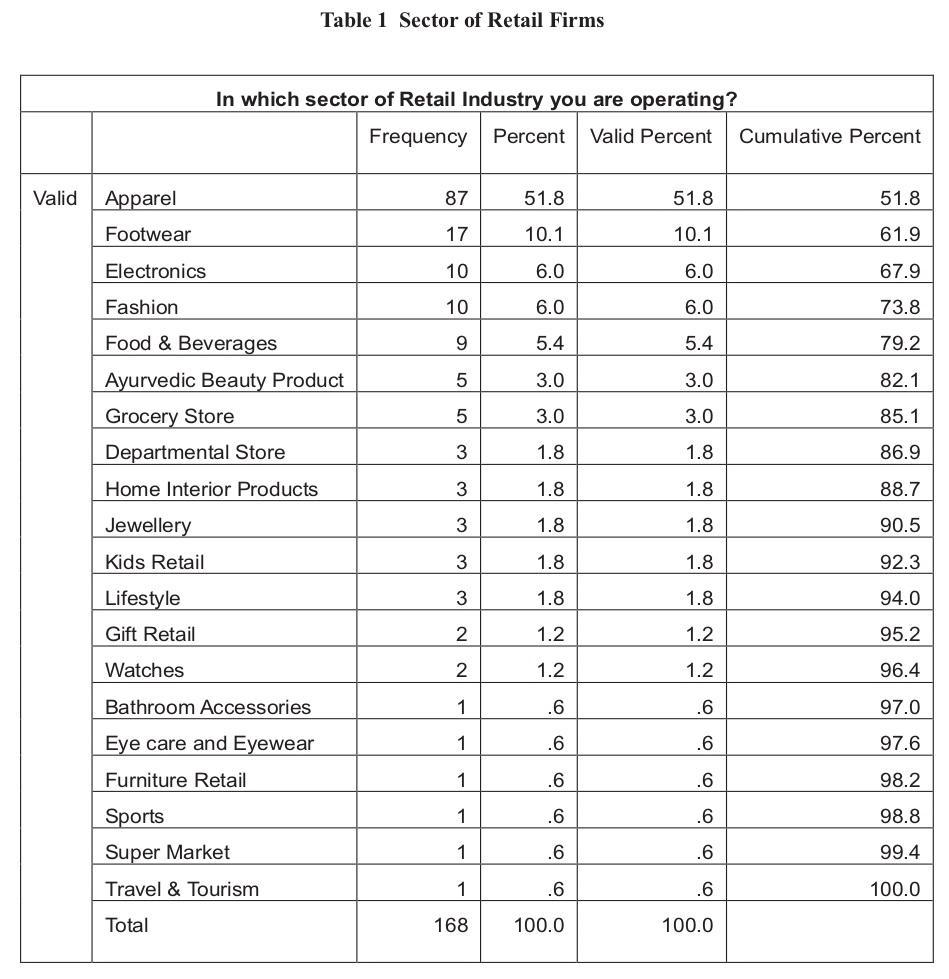
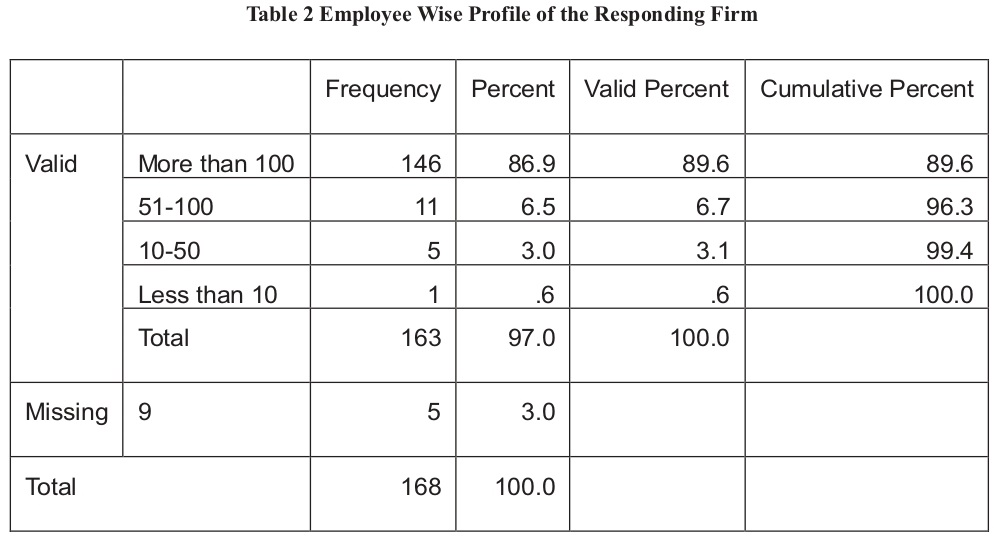
The profile of respondent who represented the firm in were female, 123 respondents were post graduates and 31 sample includes his Designation, Gender, and were undergraduates, 140 respondents are working with Qualification and how long he or she has been working the firm for 5 years or more than 5 years. with the firm. 140 respondents were male and remaining 28
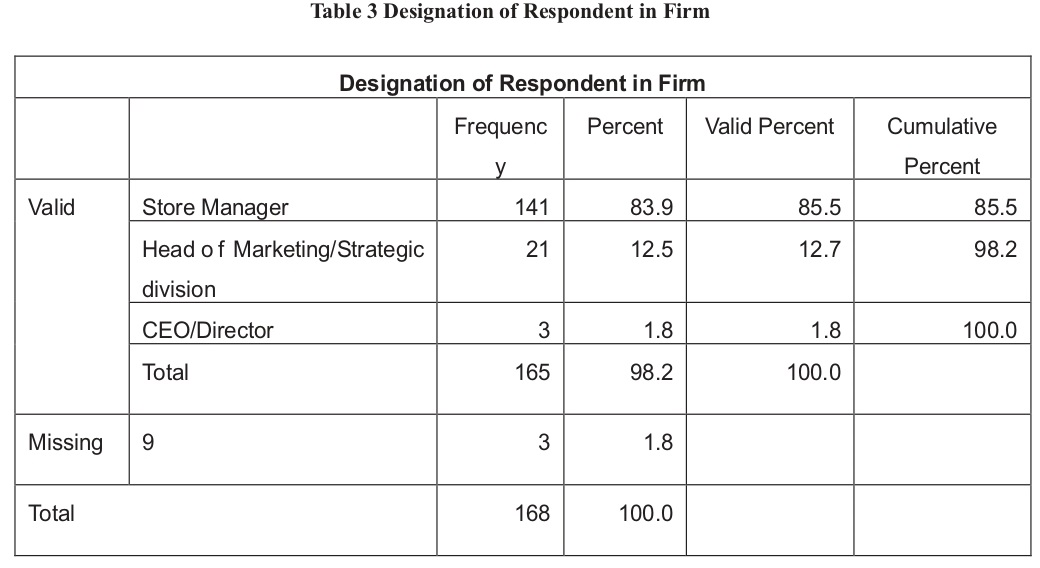
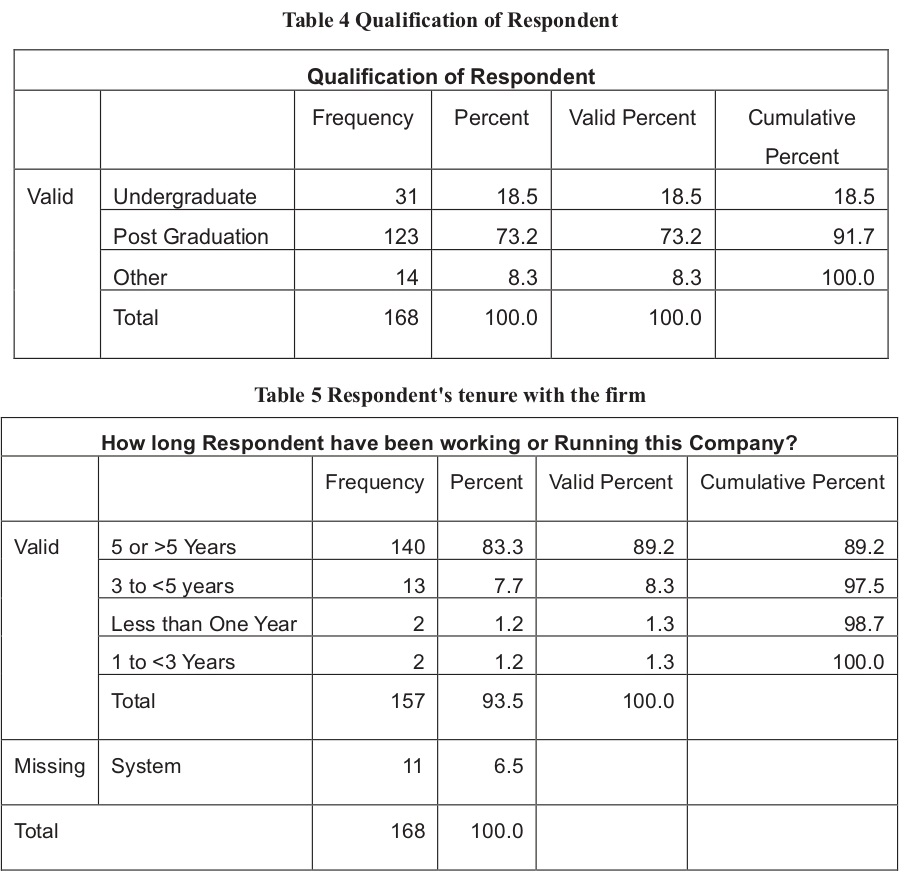
The overall performance of Indian retail firms on these phases has been investigated on the bases of the total score of the firm in the respective phase. If the average score of the firms is more than 75 % of the total score of the factor it means firms are practicing advance level of Competitive Intelligence in that respective factor. If the average score of the firms is more than 50% of the total score of the factor it means firms are practicing intermediate level. If the average score is less than 50% of the total score of it means firms are practicing a basic level of competitive intelligence in that particular factor.
This factor consists of five statements which are measured on five points Likert scale. All five statements are positive so no need to reverse the coding of statements. The total possible score in Planning and Focus construct is 25. The Indian Retail firms have mean score of 15.30. It is 61.2% of the total score. The mean score of firms on Planning and Focus is more than 50% of the total score so Indian Retail firms are practicing intermediate level of Planning and Focus.
This factor consists of five statements which are measured on five point Likert scales. All five statements are positive so no need to reverse the coding of statements. The total possible score in Collection construct is 25. The Indian Retail firms have mean score of 15.85. It is 63.4% of the total score. The mean score of Indian Retail firms on Collection factor is more than 50% and less than 75% of the total score so Indian Retail firms are practicing
This factor consists of seven statements which are Indian retail firms in terms of following competitive measured on five point Likert scales. All five statements are intelligence process are categorized as the practitioners of positive so no need to reverse the coding of statements. The the intermediate level of competitive intelligence. In the total possible score in Communication and Analysis comparison of three factors, Indian firms are competitively construct is 35. The Indian Retail firms have mean score of good in Communication and Analysis and weak in 25.29. It is 72.3% of the total possible score. The mean Planning and Focus score of Indian Retail firms on Communication and
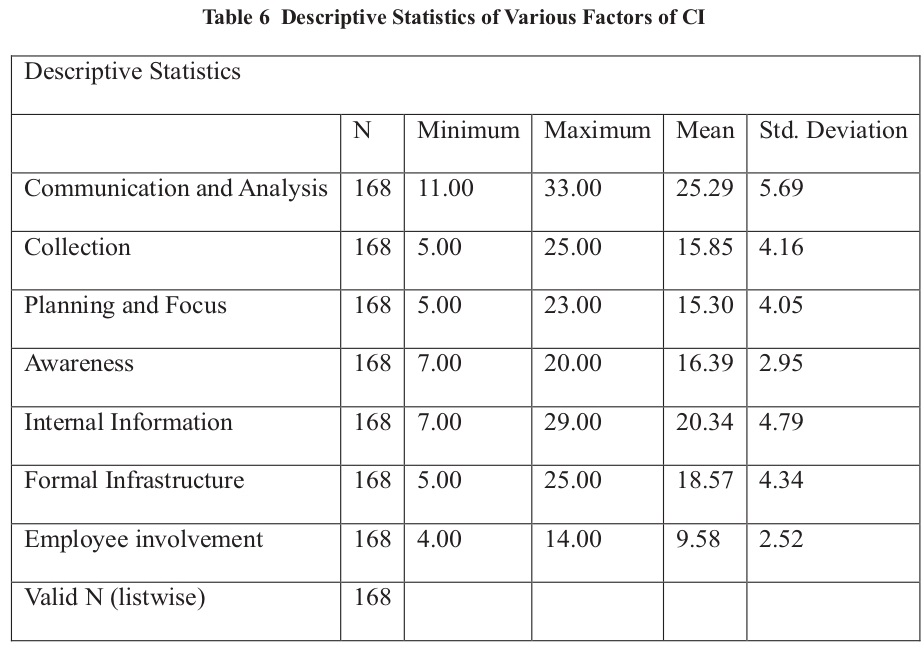
This factor consists of four statements which are measured on five points likert scale. All four statements are positive so no need to reverse the coding of statements. The total possible score in Awareness construct is 20. The Indian Retail firms have mean score of 16.39. It is 81.95% of total score. The mean score of firms on Awareness is more than 75% of the total score so Indian Retail firms have an advance level of Awareness.
This factor consists of six statements which are measured on five points likert scale. All six statements are positive sono need to reverse the coding of statements. The total possible score in Awareness construct is 30. The Indian Retail firms have mean score of 20.34; It is 67.80% of total score. The mean score of firms on Internal Information is more than 50% of the total score so Indian Retail firms have an intermediate level of Internal Information.
This factor consists of five statements which are measured on five points likert scale. All five statements are positive so no need to reverse the coding of statements. The total possible score in Formal Infrastructure construct is 25. The Indian Retail firms have mean score of 18.57. It is 74.28% of total score. The mean score of firms on Formal Infrastructure is more than 50% of the total score so Indian Retail firms have an intermediate level of Formal Infrastructure.
This factor consists of three statements which are measured on five points likert scale. All three statements are positive so no need to reverse the coding of statements. The total possible score in Employee Involvement construct is 15. The Indian Retail firms have mean score of 9.58. It is 63.98% of total score. The mean score of firms on Employee Involvement is more than 50% of the total score so Indian Retail firms have an intermediate level of Employee Involvement. Indian retail firms in terms of competitive intelligence context are having an advance level of Awareness, intermediate level of Internal Information and Formal Infrastructure and Employee Involvement.
Aguilar, F. J. (1967). Scanning the business environment. New York: Macmillan,. Dishman, P. L., & Calof, J. L. (2008). Competitive intelligence: a multiphasic precedent to marketing strategy. European Journal of Marketing , 42 (7/8), 766-785. Ferguson, N. (1998). The World's Banker: The history of the house of Rothschild. Weidenfeld & Nicolson London. Fleisher, C. S. (2008). Using Open Source Data in Developing Competitive and Marketing Intelligence. European Journal of Marketing , Vol. 42 Iss: 7/8, pp.852 - 866. Gilad, B. (2008). The Future of Competitive Intelligence: Contest for the Profession's Soul. Competitive Intelligence Magazine , 11 (5). Herschel, R. T., & Jones, N. E. (2005). Knowledge Management and Business Intelligence : The importance of Integration. Journal of Knowledge Management , 9 (4), 45-55.
York: The Free Press,. Rouach, D., & Santi, P. (2001). Competitive Intelligence Adds Value: Five Intelligence Attitudes. European Management Journal , 19 (5). Saayman, A., Pienaar, J., Pelsmacker, P. d., Viviers, W., Cuyvers, L., Muller, M. M., et al. (2008). Competitive intelligence construct exploration, validation and equivalence. Aslib Proceedings: New Information Perspectives , 60 (4), 383-411. Sawka, K. A., Frances, D. B., & Herrin, J. P. (1995). Evaluating business intelligence systems: how does your company rate? Competitive Intelligence Review (4), 22-25. Viviers, W., Saayman, A., Muller, M. L., & Calof, J. (2002). Competitive Intelligence Practices: A South African Study. South African Journal of Business Mangement , 33 (3). Walle, A. H. (1999). From Marketing Research to Competitive Intelligence:. Management Decision , 37/6 519-525. Wright, S., Eid, E. R., & Fleisher, C. S. (2009). Competitive intelligence in practice: empirical evidence from the UK retail banking sector. Journal of Marketing Management , 25, 941-964. Wright, S., Pickton, D. W., & Callow, J. (2002). Competitive intelligence in UK firms: a typology. Marketing Intelligence & Planning , 20 (6), 349360. Yap, C. S., Rashid, M. Z., & Sapuan, D. A. (2013). Perceived environmental uncertainity and competitive intelligence practice. VINE: The journal of information and Knowledge Management System , 43 (4), 462-481. Zikmund, W. G. (2003). Business Research Methods (7 ed.). New Delhi: Cenage Learning
IBEF.(2016, September,). Retrieved December 8, 2016, from http://www.ibef.org/industry/retailindia.aspx Malhotra, N. K., & Dash, S. (2013). Marketing Research An Applied Orientation (6 ed.). Delhi: Pearson Education . Porter, M. E. (1980). Competitive strategy: Techniques for analyzing industries and competition. New york.